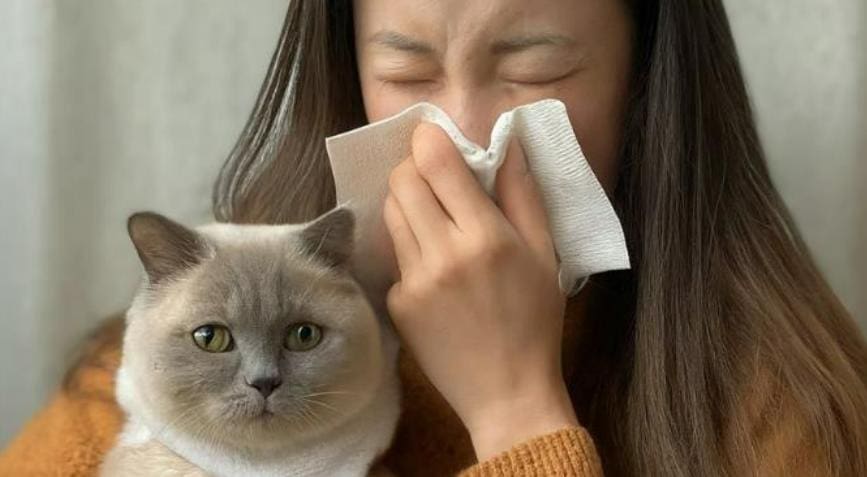A sweet, furry little fellow says “meow” and his eyes start to redden, his nose starts to run and the sneezes start to come one after the other. Sound familiar? Then you are probably allergic to cats. So what can you do?
Although cat allergies can occur at an early age, allergies can appear at any stage of life. in people with cat allergies, the reaction can be almost immediate. in milder cases, there can be a difference of 4 to 8 hours between exposure and reaction. the duration of symptoms can also vary from person to person; some people react for a few minutes, while others may take days.
Recent studies have shown that children who grow up in a cat-friendly environment have a lower risk of allergies than others. one of the most important reasons for this is breast milk.
there are seven known types of cat allergy. these allergens can be found in the hair, saliva and sometimes even in urine. the most well-known cat allergen is a protein called “feld1”. this protein is found in saliva and skin and can be passed from cat to human in any contact. dead skin can also contain this protein, but it should be remembered that it is not part of the skin; it is only on it.
The biggest problem with this protein is that it is so small that it is invisible to the eye, and because it can float in the air, it can easily affect the respiratory tract. it is also sticky, so it can easily stick to sofas, carpets, and you. because this allergen is so small and light, it cannot be detected, and its effect only lasts six months after the cat leaves the house (sometimes it can even be effective even if no cat has ever lived in the house).
Are some species safe for allergic people?
in fact, the amount of allergens does not vary from breed to breed. short-haired cats carry the same number of proteins as long-haired cats. only one study once claimed that light-haired cats carry fewer allergens than dark-haired cats. others say there is no difference. but for now, there is no way to distinguish between potentially allergenic cats.
4 ways to fight cat allergy
care for the cat
according to a clinical trial, anti-allergic sprays and shampoos partially work, but the allergens return after a few days.
but some products have been proven to minimize allergic reactions. nevertheless, keep in mind that bathing your cat too often dries out the skin and increases protein production.
one way to reduce allergies is to brush your cat’s coat daily. by doing so, you get rid of a lot of allergen-carrying hair. also, it makes sense for the allergy sufferer not to do the brushing. it is even better not to brush the cat inside the house, so that the flying allergens are not in the room.
try to solve all kinds of skin problems of your cat. healthy skin produces less protein.
if your cat is tame, washing it every week with an anti-allergenic shampoo helps.
change your cat’s diet; foods rich in omega 3s are also good for your cat’s skin. do not feed your cat any processed food. this type of food harms both your cat and its skin.
change the mood of the house
although daily vacuuming is recommended, it can sometimes have the opposite reaction! most allergic individuals vacuum too often. the filters of vacuum cleaners release small allergens back into the air through the filter. this does not ensure a healthy cleaning.
for the vacuum cleaner to be more effective, you should use a micro filter. such filters can filter out even the smallest allergens. proteins can be found not only in carpets and curtains, but also on the edges of walls. so make sure that your vacuum cleaner can reach every corner. of course, the allergy sufferer should never be the one doing the vacuuming.
when vacuuming, it is effective to use a furniture spray. proper dust removal minimizes the number of allergens.
reduce the number of fabrics in your home. carpets accumulate a lot of allergens. lampshade curtains are less allergenic than fabric curtains. but they need to be cleaned very carefully. try to choose hypoallergenic pillows rather than feather pillows.
protect yourself
Of course, there are precautions you need to take for yourself:
a. wash your hands! when you spend minutes cuddling and kissing your cat, immediately wash your hands with warm water and soap. make it a habit.
b. wash your clothes often. try not to wear the same clothes over and over again. try to wash them even if they are not very dirty. washing machines are very effective at removing allergens. try to use a hypoallergenic detergent. dry cleaning is also an important tool for removing allergens.
c. no, no kitty! as cute as this is, don’t let your cat rub against your face and play with tiny bites. remember that most allergens are found in cats’ saliva.
d. talk to an allergist. as we said at the beginning of this article, there are many types of allergies. for the best solution, it is best to find out the source of your allergy.

